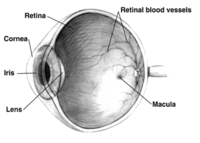
Photo from wikipedia
Abstract Purpose To evaluate the outer retinal band thickness and choriocapillaris (CC) visibility in four distinct retinal regions in dogs and cats imaged with spectral domain optical coherence tomography (SD‐OCT).… Click to show full abstract
Abstract Purpose To evaluate the outer retinal band thickness and choriocapillaris (CC) visibility in four distinct retinal regions in dogs and cats imaged with spectral domain optical coherence tomography (SD‐OCT). To attempt delineation of a fovea‐like region in canine and feline SD‐OCT scans, aided by the identification of outer retinal thickness differences between retinal regions. Methods Spectralis® HRA + OCT SD‐OCT scans from healthy, anesthetized dogs (n = 10) and cats (n = 12) were analyzed. Scanlines on which the CC was identifiable were counted and CC visibility was scored. Outer nuclear layer (ONL) thickness and the distances from external limiting membrane (ELM) to retinal pigment epithelium/Bruch's membrane complex (RPE/BM) and ELM to CC were measured in the area centralis (AC), a visually identified fovea‐like region, and in regions superior and inferior to the optic nerve head (ONH). Measurements were analyzed using a multilevel regression. Results The CC was visible in over 90% of scanlines from dogs and cats. The ONL was consistently thinnest in the fovea‐like region. The outer retina (ELM‐RPE and ELM‐CC) was thickest within the AC compared with superior and inferior to the ONH in dogs and cats (p < .001 for all comparisons). Conclusions The CC appears a valid, albeit less than ideal outer retinal boundary marker in tapetal species. The AC can be objectively differentiated from the surrounding retina on SD‐OCT images of dogs and cats; a fovea‐like region was identified in dogs and its presence was suggested in cats. These findings allow targeted imaging and image evaluation of these regions of retinal specialization.
Journal Title: Veterinary Ophthalmology
Year Published: 2022
Link to full text (if available)
Share on Social Media: Sign Up to like & get
recommendations!